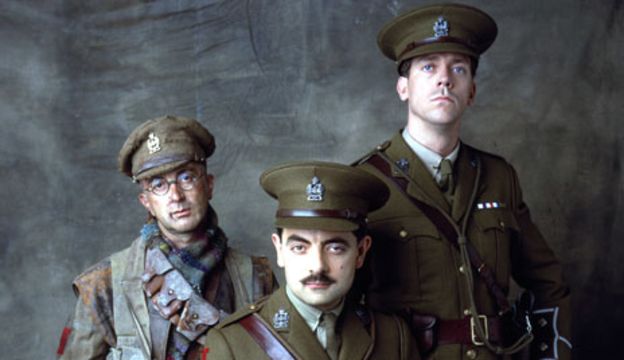On the 100th anniversary of World War I, a military genealogy site has found an actual Captain Blackadder, a Private Baldrick, a Lieutenant George, and a Captain Darling. All are names of characters on the popular BBC television program Blackadder. But there were actual soldiers in the conflict that shared more than just names and ranks with their fictional counterparts.
The characters were created by Richard Curtis, Rowan Atkinson, and Ben Elton. Blackadder covered four periods in history, with the show ending in World War I where the characters go over the top, apparently to their deaths in an unexpectedly moving and solemn ending to this light-hearted series.
Researchers from Forces War Records went through six million military records to locate the stories of the soldiers who share the names of the fictional characters. All of the men they found served in the trenches, just like their namesakes.
Captain Robert John Blackadder was born in January 1884 in Dundee, Scotland. He graduated in Scots law from University College in Dundee. He worked as an accountant before enlisting. He served as a rifleman in the Queen’s Westminster Rifles, working his way up to Captain in the North Scottish Royal Garrison Artillery.
He fought in the Battle of the Somme in 1916 and received the Military Cross in 1918 for his “conspicuous gallantry”. After the war, he moved to Sussex, where he died at the age of 84.
Private James Baldrick was born in 1892. He was raised in Londonderry, eventually working as a shop porter in Omagh. He enlisted in the army reserves. He fought in the Battle of Le Cateau after being called up for regular service with the British Expeditionary Force. He was killed at the age of 23 in the Battle of Messines. His name is on the Ploegsteert Memorial in Belgium.
Captain John Clive Darling was born in 1887. He was the only son of The Honourable Mr. Justice Charles John Darling, 1st Baron Darling and Mary Caroline Darling. He went to school at St. Neots School and Eton. He took his commissioning course at Sandhurst before joining the cavalry.
In the war, he served as the signaling officer to the 20th Hussars. He retired in 1923 as a Major. He was awarded the Distinguished Service Order and authored a book about his time in the service called 20th Hussars in the Great War.
Lieutenant Athelstan Key Durance George was born in 1887 in Brixton, London. He was a direct descendant of Sir William Bloet, who fought with William the Conqueror. He studied medicine at Cambridge University. There, he excelled at rowing and fencing before dropping out to join the army.
He was assigned to the King’s Liverpool Regiment in 1907 and was described by his Colonel as the best 2nd lieutenant he had ever had. In August of 1914, he passed an aviation course and headed for the Western Front. There, he fought in the Battles of Mons, Le Cateau, and Marne. He was killed at Marne in September of 1914.
The chief executive of Forces War Records, Dominic Hayhoe, said that “We were uploading new information into our database when we came across a Captain Blackadder. As fans of the television show, we wondered if we could find the military records of the other fictional characters’ namesakes. So we challenged our team of professional researchers and military experts, who are all based in the UK so are familiar with the Blackadder series, to find them, which they did. The only person we haven’t been able to track down so far from World War I is a General Melchett. But according to the military records we have, he makes an appearance in World War II.”
Blackadder was on the air from 1983 until 1989. It started with a series in the Middle Ages, then moved to the Elizabethan Era, then the Regency period, and ended with World War I.
